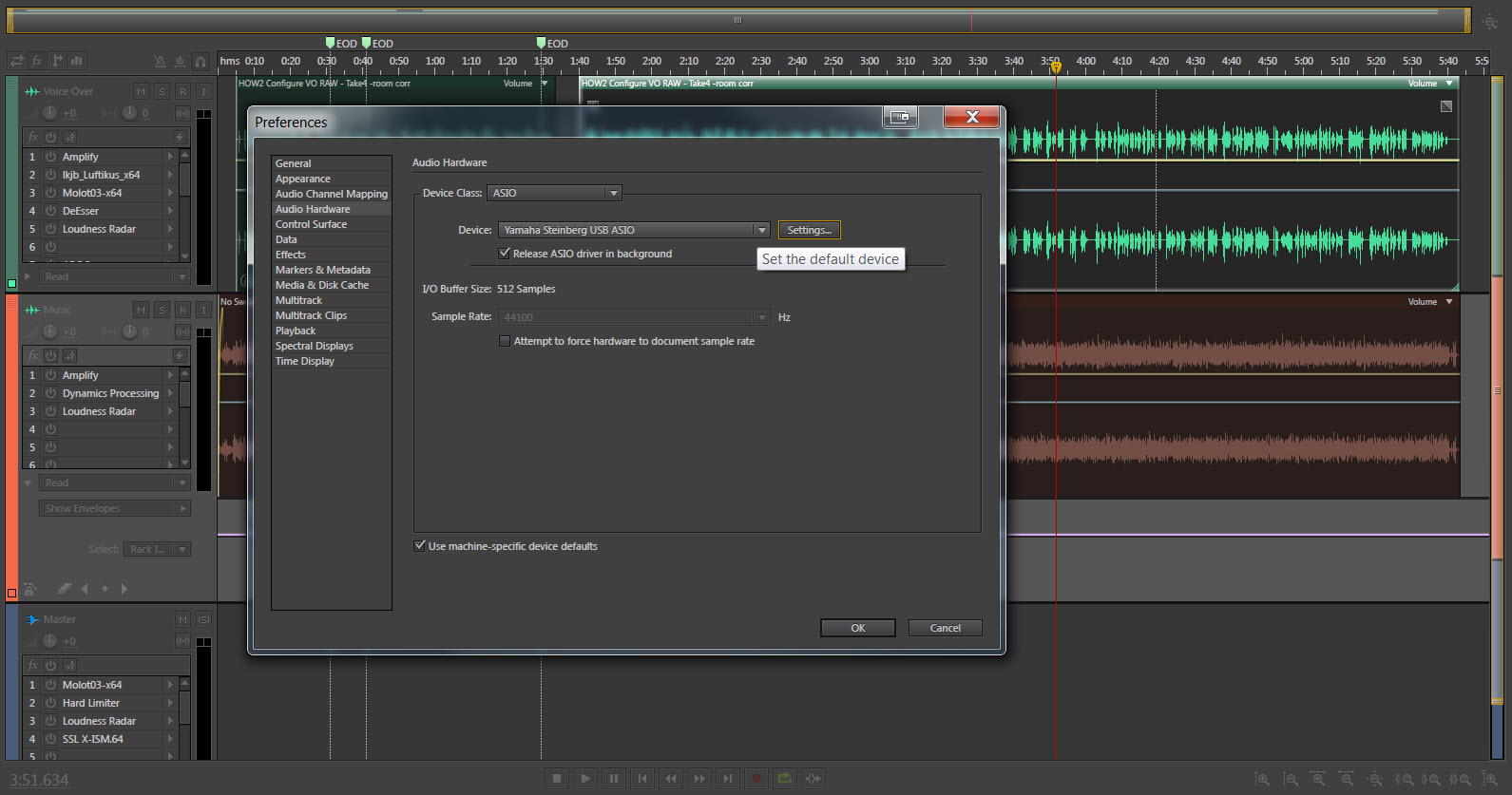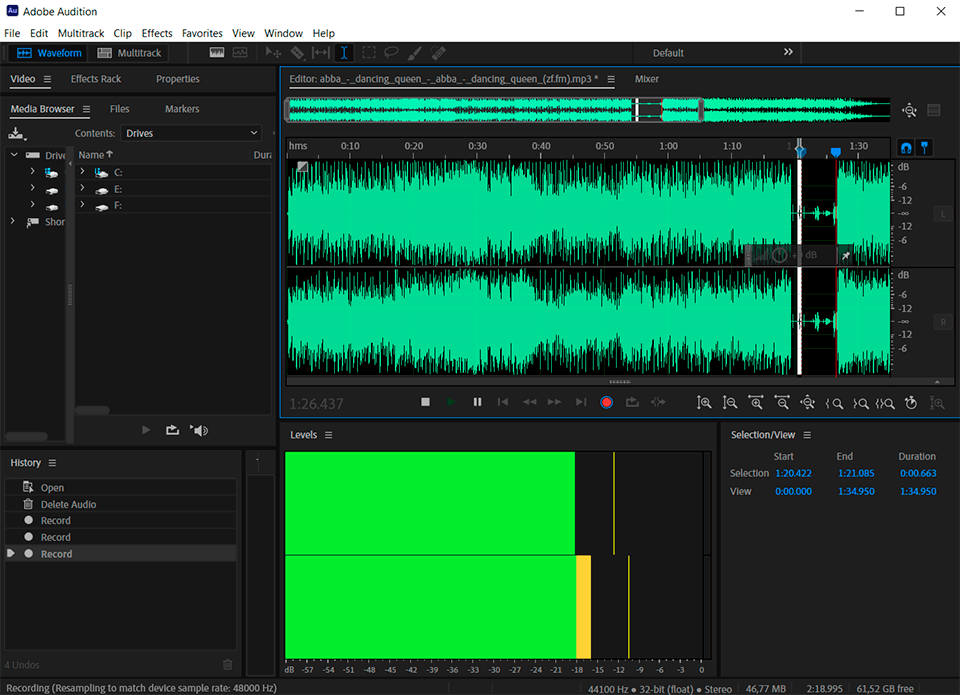Adobe Audition is a well-known audio wave editor. By default it simply captures sound input through microphone. If you want to record internal sound on your computer with Audition, you need a virtual sound card which can route the Mac sound to Audition instead of your speaker. First things first is we need to start up a new audio file. Audition will start you up on a blank, empty screen, so you can't record just yet. It should look like the picture below. What you need to do here is click 'File', hover over 'New' then click 'Multitrack Session' or hit the key combo Ctrl + M.
This might sound like the simplest of audition recording tips, but it can be the most overlooked. “Good enough” will not get you what you want. If you do not have access to the right space or equipment to produce a high-quality recording, consider your options. Access the Waveform of your audio by double-clicking on the track. Head over to Window Amplitude Statistics. A new window will open. Click on the Scan option in the lower left-hand corner. Adobe Audition CC. Be sure that Audition is working properly and ready to operate and then, press 'Multitrack' in the upper-left corner to be able to have access to multiple recording tracks; it will make it easier to record more content at once and mixing it together. Name the file accordingly and save it at the location needed.
My podcast, the Digital Production Buzz, uses Skype every week to record audio interviews.
One of big benefits of Skype is that it can reach around the world, without any long-distance phone charges. One of the disadvantages is that the audio quality can vary – wildly.
I make a point to set audio levels before each interview, yet, sometimes I am still surprised. Levels change due to the voice of the speaker, the quality of the audio gear they are using, whether the Audio/Video preferences panel is open or closed, and the quality of the Internet signal.
In other words, there’s no assurance that anything will go right.
Here is a typical example. The first half of this audio is severely clipped because the recording level was too high; it sounds “crunchy,” almost distorted. Then, in the second half, the level is normal because I corrected the problem in the middle of the recording.
NOTE: This technique can be used on any audio file that was recorded at too loud a level.
Recording Audio In Audition
One of the benefits to using Adobe Audition to edit audio is that it has a very powerful tool to clean up this mess. What we need to do is reduce the overall level of the loudest portion of the clip, then fix the crunchy clipping using the Declipping tools. Here’s how.
Import the offending audio clip in Audition, then double-click it to display it in the Waveform Editor. (This feature has been in the software for several years, so you don’t need to be running the latest version.)
Select the area of the waveform that is too loud in the Waveform Editor.
NOTE: If the entire clip is too loud, select the entire clip (shortcut: Cmd+A).
Using the floating palette, reduce the level of the selected region. We need to give the clip some audio headroom to allow room for the correction. I generally try to get it close to matching the level of the rest of the audio.
NOTE: If you are correcting an entire clip, lower the level about 6 dB.
Choose Window > Diagnostics.

Make sure the Effect is set to DeClipper, and the Preset to Default.
Click the Scan button, near the top left corner of the panel.
Scanning the file found 258 problems with potential clipping. The bad news is that there is a LOT of problems. The good news is that there is a very fast way to fix them. It’s time for some magic.

Click the Repair All button, just below the Scan button. This button only lights up after you’ve scanned a clip.
Look at the waveform and notice how all the dynamic range is now back in the clip.
Click Scan again to see if there are any problems.
NOTE: With severe clipping you may need to do this procedure twice.
However, in this case, the audio levels of the corrected clip are still significantly louder than the second half of the clip. While you can select the louder region and reduce the level, my recommendation, instead, is to use Undo to go back to just before you dropped the levels on the distorted clip.
Then, lower the levels a bit further using the floating palette, rescan for problems, then click Repair All. By starting from the original clip, you retain more quality that if you continually adjust and correct the same portion of a clip.
Poof.
You know you’ve done it right when re-scanning does not show any clipped samples and the waveforms look reasonably similar, as they do here. The 2-3 dB differences in level between these two sections of a clip can easily be handled during the mix.
Done.
Bookmark the permalink.Recording Audio
You can record audio files in Audition directly. You’ll need to go to File > New > Audio File (Shift + Cmd + N), which will create a new audio file. Then to record onto this audio file, you’ll need to hit record at the bottom and record what you want, then click Record again or Stop to stop recording.
Audition Audio Editor
Trimming Files
During your recording, you may have coughed or said “ummm” too many times, so you will defeintly need to remove them. There are two ways of doing this.
The first way is simply highlighting the section of audio you want to remove, and then pressing Delete on your keyboard. The only problem with this method is that you might hear a jump in the audio where you cut a bit out. This method is generally more useful for removing things at the beginning or end of your recording.
The second way is to select the Razor Tool (R) in the top toolbar. You can use this to make a cut before and after the part of audio you want to remove. Then select the chunk of audio you’ve cut out, and press Delete on your keyboard to get rid of it.
Adding Audio Files
To add in audio files, you can either drag and drop them into the little library box, drag them directly onto the timeline, or click the Upload Media button (It just looks like a little file!).
You can then add these to whatever track you like in the Multitrack Session by dragging and dropping them where you want them.
Multitrack Sessions
This is where you will do the bulk of your editing. You’ll need to open a new Multitrack Session by going to File > New > Multitrack Session (Cmd + N) or just clicking the Multitrack button at the top.
In the Multitrack area you can see there are quite a few tracks, and you can think of these as layers. This is how you will layer music underneath talking, for example. For this example, we’re going to be layering Music, Speech and a Sound Effect.
In this area, you can drag your audio files around to make them play out exactly when you want them to. For example, this will be the introduction to our podcast, so we have the host briefly introducing the episode, followed by the opening jingle, then a sound effect of a telephone, then the host continuing the episode.
Ducking Volume and Panning Sounds
What about adjusting the volume of music so it sits under the host talking? Or adjusting an interview piece so one person is on the right and the other on the left when you listen with headphones? Well, you can do that in Multitrack too!

This yellow line is the clips volume gain. Using this you can adjust the volume easily, making it fade in and out. Click wherever you want on the line to add in a Keyframe. Think of these like pins. Then slightly further down the line, we’ll add another Keyframe, then click and drag this one down. This now means that the volume will follow the line, getting quieter as the line goes down.
The white/grey line is the Panning on the clip. This line determines whether the clip will sound more on the left, right or centre. You can add Keyframes to this too to pan the audio from left to right, with left being up and right being down.
Editing Podcast Audio Using Audition
The basics of editing podcast audio using Audition are easy to master, but there are loads more you can be doing to sound better. Whether you don't have time or just want to sound your best, we can help. Hire us to edit your shows to create smooth, high-end audio experiences, whether that's for you or your client.
